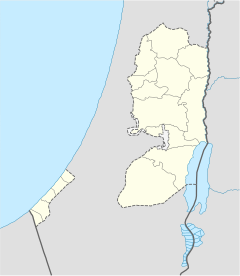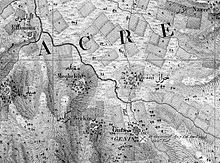Burqin (West Bank)
| Burqin | ||
| Administration : |
|
|
| Governorate : | Jenin | |
| Coordinates : | 32 ° 27 ' N , 35 ° 16' E | |
| Height : | 220 m | |
| Residents : | 5,685 (2007) | |
| Community type: | city | |
|
|
||
Burqin ( Arabic برقين) is a Palestinian city in northern West Jordan , five kilometers west of Jenin . According to the Palestinian Central Bureau of Statistics (PCBS) census, the city had a population of 5,685 in 2007. The majority of the residents are Muslims , and 20 Christian families also live in the city. Dating from the Byzantine era, the Burqin Church or St. George's Church is one of the oldest churches in the world.
history
Burqin is an old place that sits on a hillside with old stones that have been reused in the townhouses.
Burqin was founded in the 14th century BC. BC mentioned in the Amarna letters as one of several cities that were conquered by the Canaanite warlord Lab'aia in the Sahl Arraba and south of the Jezreel plain .
Remains from the Bronze Age , Early Bronze IIB, Late Bronze III Iron Age , Ice Age , Late Roman , Byzantine , Umayyad / Abbasid , Medieval and early Ottoman era have been found in Burqin.
Ottoman era (1517-1920)
In 1517 Burqin was incorporated into the Ottoman Empire along with the rest of Palestine , and it appeared as Bruqin in the tax registers from 1596 . The population consisted of 23 households and 4 bachelors, all Muslim . They paid a tax rate of 33.3% on agricultural products, including wheat, barley, summer crops, olive trees, occasional income, goats and beehives; a total of 7980 Akçe .
In 1799, Pierre Jacotin placed the village of “Berkin” almost directly west of Jenin on his map. In 1838 Edward Robinson moved Burqin to Jenin District, also known as Haritheh esh-Shemaliyeh.
The French explorer and amateur archaeologist Victor Guérin visited the place, then inhabited by 90 Greek Orthodox Christians and 910 Muslims, in 1863 and found around 30 excavated cisterns , which he interpreted as evidence of the place's structure on an old settlement.
In 1882 the Palestine Exploration Fund described Burkin as "A village of the Greek Christians, with a small modern church for the Greek rite, on the side of a white hill, with a good well to the north and olive trees nearby."
British mandate 1920–1948
In the 1922 Palestine Census conducted by the British Mandate Government , Burqin had 883 residents; including 871 Muslims and 12 Christians. This increased to 1086 in the 1931 census; 76 Christians, the rest Muslims, in a total of 227 houses.
According to village statistics from 1945, the population of Burqin had grown to 1,540 people, with 19,447 dunams of land, according to an official land and population survey. Of these, 3,902 dunams were used for plantations and irrigable land, 11,219 dunams for grain, and 36 dunams were cultivated.
1948 to the present
In the course of the Palestine War and after the armistice agreements in 1949, Burqin came under Jordanian rule.
Burqin has been under Israeli occupation since the Six Day War in 1967 . Burqin has been under Palestinian autonomy since 1995 . In Burqin there have been numerous confrontations with the Israeli occupation forces since 1967, with a large number of dead and injured in the population.
tourism
Burqin and the Palestinian Ministry of Tourism are working to market Burqin Church (St. George's Church) as a tourist destination. City facilities are being upgraded to accommodate more tourists. The USA (USAID) is funding a project to renovate an old building into a center for tourists, where they can be offered general lectures and screenings before visiting the church and other historic locations in the city.
The municipality is in negotiations with UNESCO about the inclusion of the city as a World Heritage Site .
literature
- Barron, JB (Ed.): Palestine: Report and General Abstracts of the Census of 1922 . Government of Palestine, 1923.
- CR (Claude Reignier) Conder : Tent work in Palestine. A record of discovery and adventure , Volume 1. R. Bentley & Son, London 1878.
- Claude Reignier Conder, HH Kitchener: The Survey of Western Palestine: Memoirs of the Topography, Orography, Hydrography, and Archeology , Volume 2. Committee of the Palestine Exploration Fund , London 1882.
- Claudine Dauphin: La Palestine byzantine, Peuplement et Populations, Vol. III: Catalog (= BAR International Series 726). Archeopress, Oxford 1998.
- Goren (Ed.): Inscribed in clay: provenance study of the Amarna tablets and other ancient Near Eastern texts . Emery and Claire Yass Publications in Archeology, 2004.
- Victor Guérin : Description Géographique Historique et Archéologique de la Palestine ( French ), Volume 2: Samarie, pt. 2. L'Imprimerie Nationale, Paris 1875.
- Sami Hadawi : Village Statistics of 1945: A Classification of Land and Area ownership in Palestine . Palestine Liberation Organization Research Center, 1970.
- Wolf-Dieter Hütteroth, Kamal Abdulfattah: Historical Geography of Palestine, Transjordan and Southern Syria in the Late 16th Century . Erlangen Geographical Works, special volume 5. Erlangen, Germany: Board of Directors of the Franconian Geographical Society, 1977, ISBN 3-920405-41-2 .
- Mills, E. (Ed.): Census of Palestine 1931. Population of Villages, Towns and Administrative Areas . Government of Palestine, Jerusalem 1932.
- EH Palmer : The Survey of Western Palestine: Arabic and English Name Lists Collected During the Survey by Lieutenants Conder and Kitchener, RE Transliterated and Explained by EH Palmer . Committee of the Palestine Exploration Fund , 1881.
- Edward Robinson, Eli Smith: Biblical Researches in Palestine, Mount Sinai and Arabia Petraea: A Journal of Travels in the year 1838 , Volume 3. Crocker & Brewster , Boston 1841.
- Adam Zertal : The Manasseh Hill Country Survey , Volume 1. BRILL, Boston 2004, ISBN 90-04-13756-4 .
Web links
- Burqin Municipality website
- Welcome to Burqin
- Burqin Church , Jenin visitor center
- Survey of Western Palestine, Map 8: IAA , Wikimedia commons
- Map, 1946
Individual evidence
- ↑ 2007 Locality Population Statistics Palestinian Central Bureau of Statistics . p. 105.
- ^ Georgskirche in Burquin , accessed on October 19, 2017.
- ↑ Dauphin, 1998, p. 751
- ↑ Goren et al., 2004, p. 262 .
- ↑ a b Zertal, 2004, pp. 104 -105
- ↑ a b Noted in 1838 by Edward Robinson ; according to Robinson and Smith, 1841, vol 3, p. 159
- ↑ Hütteroth and Abdulfattah, 1977, p. 128
- ↑ Robinson and Smith, 1841, vol 3, 2nd app, p. 130 , no 8
- ↑ Guérin, 1875, pp. 223 -24
- ^ Conder and Kitchener, 1882, SWP II, pp. 46 -47
- ^ Barron, 1923, Table IX, Sub-district of Jenin, p. 30th
- ↑ Mills, 1932, p. 67
- ^ Government of Palestine, Department of Statistics. Village Statistics, April, 1945. Quoted in Hadawi, 1970, p. 54
- ^ Government of Palestine, Department of Statistics. Village Statistics, April, 1945. Quoted in Hadawi, 1970, p. 98
- ^ Government of Palestine, Department of Statistics. Village Statistics, April, 1945. Quoted in Hadawi, 1970, p. 148
- ↑ Bornstein, 2002, p. 48
- ↑ Palestinians struggle to recover from Qabatiya blockade , February 22, 2016
- ^ Morris, 2011, p. x
- ↑ 1995 Oslo Interim Agreement . Text of the Accord

